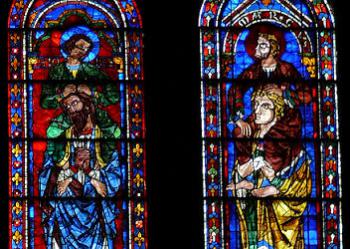The schools of Chartres
In 1895 the abbé Clerval published a famous work showing that during the Middle Ages Chartres was the seat of a particularly brilliant school. Basing his research on the municipal archives, he described its organization, discussed the masters and underlined its influence. In 1927 Haskins presented the school as one of the beacons of the “Renaissance of the twelfth century”. Calling into question the existence of that school, Richard Southern sparked a fruitful controversy in 1970, to which Nicolas Häring, Roberto Giacone, Peter Dronke, Edouard Jeauneau and Jean Châtillon have contributed. The debate has clarified what one understands as “school”. Indeed, earlier authors tended to superimpose two notions, namely that of an institutional school (a place of learning) and an intellectual school (doctrinal current).
If the existence at Chartres of an institutional school is accepted, the question of the intellectual school is more delicate. Today no one denies that personal relations and doctrinal affinities existed within a group of masters and thinkers, among whom several are known to have taught at Chartres. Nonetheless, this same group had attachments with other places of teaching, such as Tours, Poitiers, Paris and Normandy. It is thus more exact to speak of a constellation of masters who had privileged relations with the city of Chartres, but whose influence spread first to the north-west of the kingdom, before extending to all of Western Europe through manuscript copies.
Among the traits that give this nebulous school its intellectual identity, most important are:
- the influence of the Plato’s Timaeus and other neoplatonic sources: Martianus Capella, Macrobius, Boethius, and an effort to show that their thought, interpreted with the help of the notion of integumentum (metaphorical expression), is compatible with Christian faith;
- an interest for the language arts, especially grammar and the texts of classical authors, and for questions of cosmology and physics.
“We are dwarfs perched on the shoulders of giants. We can see more and further than they did, not because our sight is superior, or because we are taller than they, but because we are raised up and borne on high by their giant stature.” (Bernard de Chartres)
A Bibliography
- Alexandre Clerval (abbé), Les écoles de Chartres au Moyen Âge du Ve au XVIe siècle, Paris, 1895 (réimpr. Slatkine, 1977)
- Charles H. Haskins, The Renaissance of the Twelfth Century, Cambridge (Mass.), 1927.
- Joseph-Marie Parent, La doctrine de la création dans l’école de Chartres : études et textes, Paris, 1938 (Publications de l’Institut d’études médiévales d’Ottawa, 8).
- Tullio Gregory, Anima mundi. La filosofia di Guglielmo di Conches e la Scuola di Chartres, Florence, 1955.
- Peter Dronke, « New Approaches to the School of Chartres », dans Anuario de Estudios medievales, t. 6, 1969, p. 117-140.
- Peter Dronke. , Fabula : Explorations into the uses of myth in medieval platonism, Leyde – Cologne, 1974.
- Richard W. Southern, Medieval humanism and other studies, Oxford, 1970.
- Édouard Jeauneau, Lectio philosophorum. Recherches sur l’École de Chartres, Amsterdam, 1973.
- Roberto Giacone, « Masters, books and library at Chartres according to the cartularies of Notre-Dame and Saint-Père », dans Vivarium, t. 12/1, 1974, p. 30-51.
- Robert Louis Benson - Giles Constable (dir.), Renaissance and Renewal in the Twelfth Century, Cambridge (Mass.), 1982 (réimpr. Toronto University Press, 1991).
- Martine Mari, Les écoles de Chartres, centre culturel pour l’Europe : Xe-XIIe siècles, Chartres, 1990 (Au temps des rois).
- Edouard Jeauneau, L’âge d’or des écoles de Chartres, Chartres, 1995.
- Michel Lemmoine, Théologie et platonisme au XIIe siècle, Paris, 1998 (Initiations au Moyen Âge).
- Jacques Verger, Culture, enseignement et société en Occident aux XIe et XIIe siècles, Rennes, 1999.
- Théologie et cosmologie au XIIe siècle, l'École de Chartres, textes de Bernard de Chartres, Guillaume de Conches, Thierry de Chartres et Guillaume de Saint-Thierry réunis et traduits par Michel Lemoine et Clotilde Picard-Parra, Belles lettres, 2004.
- Pierre Riché – Jacques Verger, Des nains sur des épaules de géants. Maîtres et élèves au Moyen Âge, Paris, Tallandier, 2006
- Irene Caiazzo – Barbara Obrist (dir.), Guillaume de Conches : philosophie et science au XIIe siècle, Florence, 2011 (Micrologus’ Library, 42).
- Édouard Jeauneau, Rethinking the School of Chartres, Toronto, 2009 (Rethinking the Middle Ages, 3).
Gilbert de la Porrée and his disciples Jordan Fantosme, Ivo of Chartres and John Beleth.
Gilbert de la Porrée, Commentaries on Boethius. Saint-Amand, 12th century (4th quarter).
Valenciennes, Bibl. mun., ms. 197, f. 4v.
Evangelists perched on the shoulders of the prophets. Stained glass from the Cathedral of Chartres.


